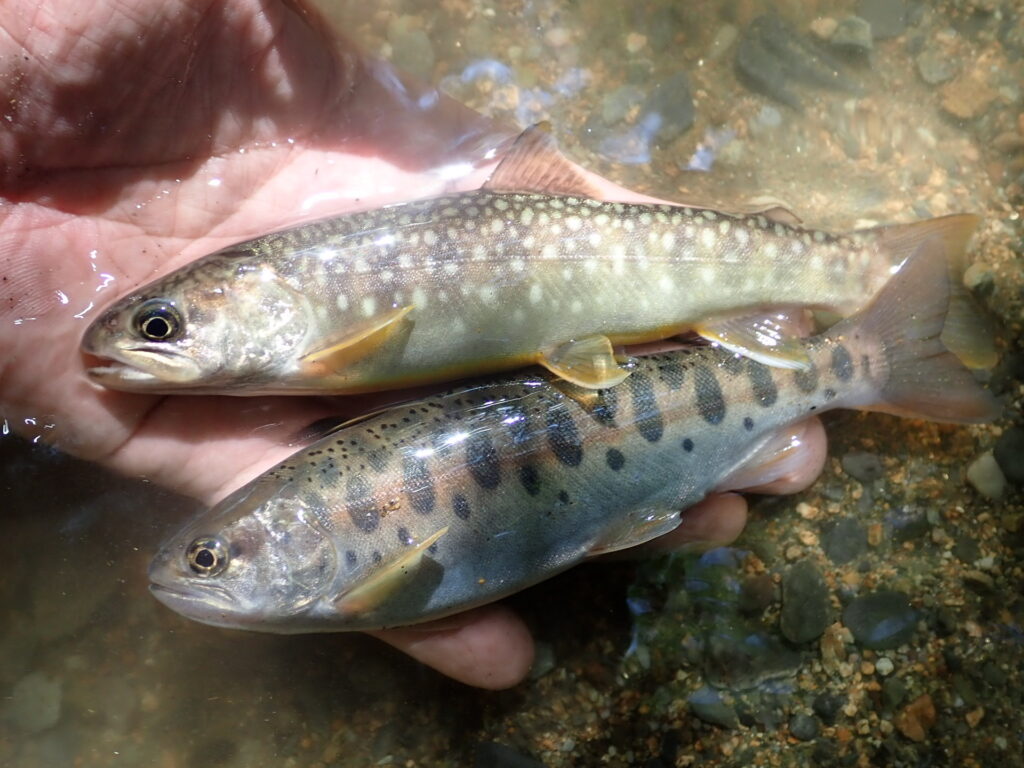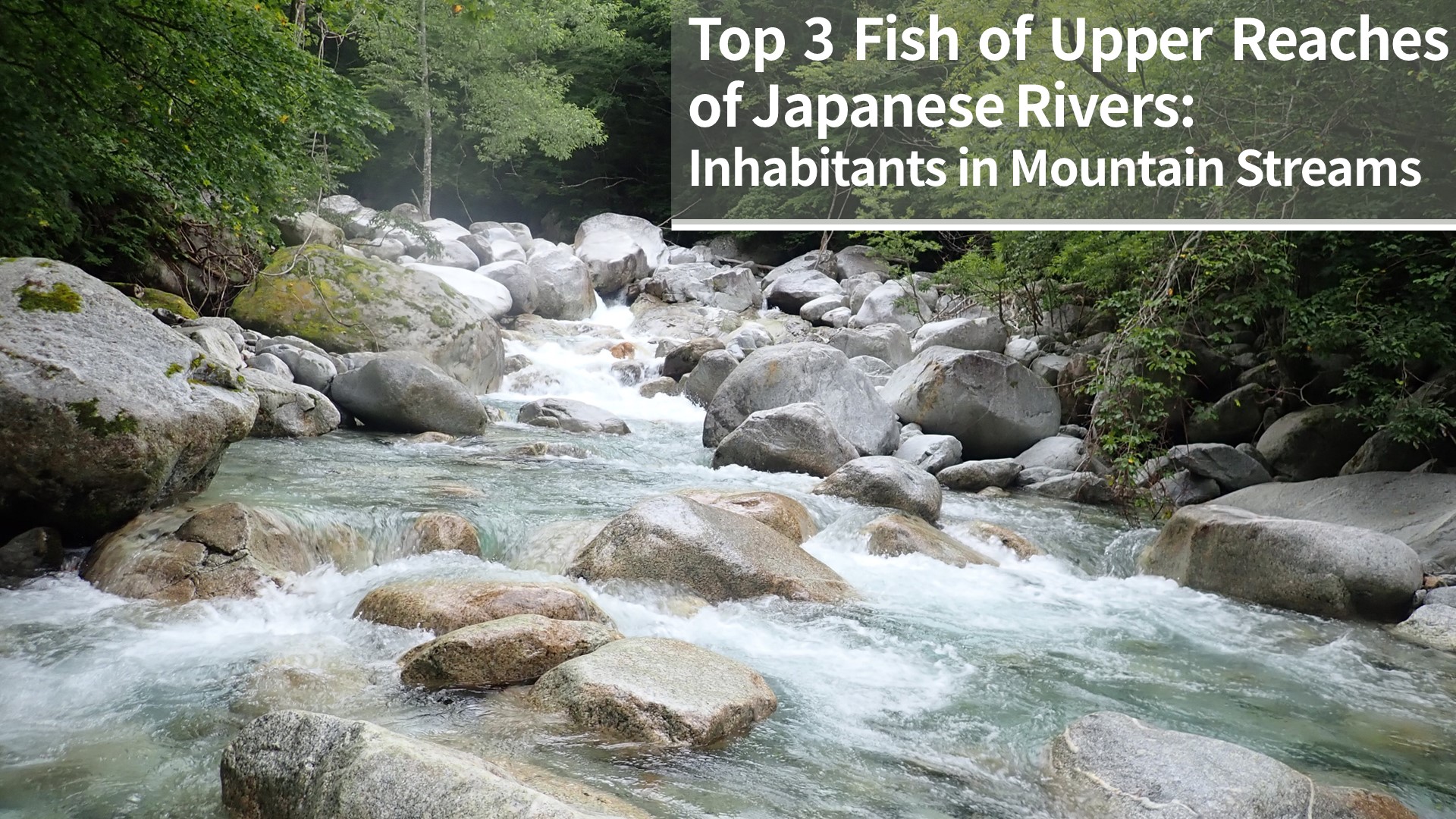Have you ever been mountain climbing? During such an excursion, you must have crossed several streams or seen rivers flowing between the mountains. These natural features are known as “mountain streams,” forming the upper parts of many rivers in Japan. Mountain streams are characterized by cold water, steep gradients with rapid flows, large rocks, narrow river widths, and low water volumes. These conditions create a harsh environment for fish, yet life still thrives there.

In Japan’s mountain streams, just three fish species play a central role. These fish have adapted to this harsh environment. Let’s take a closer look at these fish.
1. Iwana (Salvelinus leucomaenis)

Bottom: Yamame (landlocked cherry salmon:Onchorhinculs masou)
Iwana (white spotted char : Salvelinus leucomaenis) belongs to the salmon family and is a freshwater fish found predominantly in the upper reaches of Japanese rivers. Typically, they have a grey to brownish back with white or pale yellow spots. They can grow up to 60 cm in length, but most commonly range from 20 to 30 cm. In the fall, Iwana ascend further upstream to spawn.
Iwana are very popular targets for anglers due to their strong pull and vitality. Being carnivorous, they respond well to bait fishing with insects and lure fishing. For fishermen, Iwana provide an excellent opportunity to test their skills and knowledge.
Iwana are also valued as a food source, especially in mountainous areas where they are an important source of protein. In the mountainous regions of Japan, many shops and inns offer grilled Iwana, a dish that brings out the simple yet rich flavor of the fish. Grilled Iwana is a traditional cooking method that maximizes the delicate taste and texture of the fish, offering a special culinary experience for visitors.
As a representative fish of mountain streams, Iwana can be found even in small streams, where surprisingly large specimens are sometimes encountered. Such encounters offer anglers and nature lovers an indescribable sense of mystery and awe.
2. Yamame (landlocked cherry salmon:Onchorhinculs masou)
Yamame (landlocked cherry salmon:Onchorhinculs masou), belonging to the salmon family, is widely found in the cold waters of Japan from Hokkaido to Kyushu. Its habitat is primarily upstream, but it is found slightly downstream compared to Iwana, due to overlapping niches leading to habitat differentiation. Yamame are recognized by their distinctive blue patterns (parr marks), forming beautiful patterns. They grow up to about 40 cm in length, with a common size of 15 to 25 cm. The spawning season is around October when they migrate further upstream than their usual habitat.
Yamame are extremely popular in stream fishing, and as carnivorous fish, they are well suited to bait fishing with insects and lure fishing. In the northern part of Japan, some Yamame descend to the sea and grow larger as Sakura-masu (cherry salmon), returning to the rivers to spawn. Sakura-masu significantly differ in appearance from Yamame, showcasing nature’s marvel in how the same species can assume such different forms.
Yamame are also highly valued as food. Smaller ones are often fried while larger ones are grilled. These cooking methods enhance the delicate flavor and texture of Yamame, particularly grilling, which is an ideal way to savor their simple yet rich taste, beloved by many.

3. Kajika (scientific name: Cottus pollux)

Kajika (freshwater sculpin : Cottus pollux), a member of the sculpin family, is native to Japan. Kajika have a broader habitat range than Iwana and Yamame, encompassing the areas inhabited by both. However, their upper limit is slightly downstream compared to the sole domain of Iwana in the headwaters. Their body color varies from light to dark brown, depending on the region. Unlike Iwana and Yamame, which swim in the middle layers of rivers, Kajika move along the riverbed. They live in freshwater in Honshu, Shikoku, and the northwestern part of Kyushu, establishing territories under rocks from February to June for spawning.
Kajika are not commonly targeted in stream fishing, yet they are considered very tasty, and some people fish specifically for them. Kajika spend their entire lives in freshwater, but some related species migrate between the sea and rivers. Interestingly, despite being freshwater fish, Kajika have a flavor reminiscent of sea fish, owing to their evolutionary origin from marine species. Like Iwana and Yamame, Kajika are carnivorous and primarily feed on aquatic insects.
These three fish species are central to the ichthyofauna of the mountain stream’s upper reaches. Mountain streams are incredibly clean, and using snorkels to observe underwater, one can clearly see these fish. While nothing may be visible from above the water, adopting the underwater perspective reveals a vibrant world of active fish. I sincerely hope everyone gets to experience the beauty of this natural world.




コメント